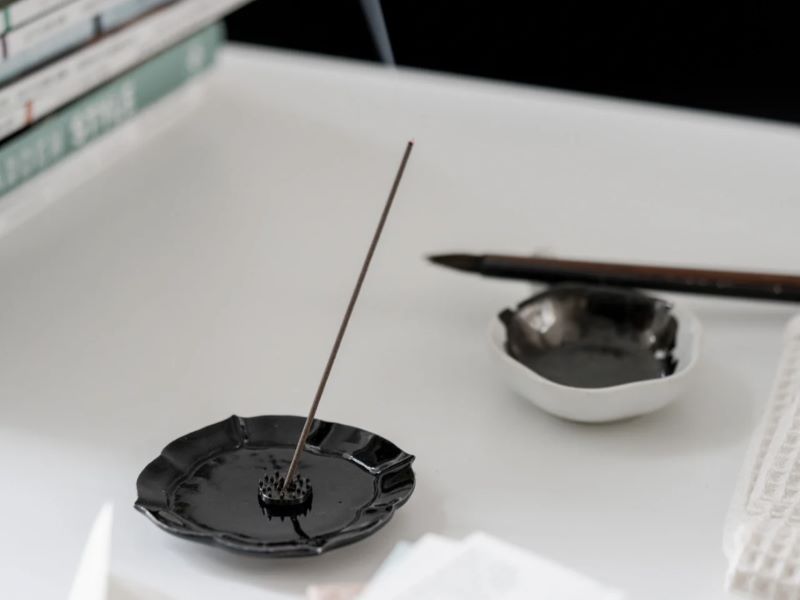When dealing with open flames, it’s obvious that they’re potentially dangerous. But after lighting incense, you might ask yourself if incense can cause a fire.
Smoldering heat from lit incense can cause a fire just as an open flame can. You should never leave the room when incense is burning because it’s possible for any heat source to ignite flammable objects or fabrics.
Let’s look at some ways to stay safe while enjoying incense.

Are Fires Caused by Incense?
Similar to candles, if incense is left burning unattended, it can potentially cause a fire. Since there isn’t an open flame, the way in which the fire starts is slightly different, though.
One way for an incense to cause a fire is when it’s left unattended.
Since there isn’t an open flame, many people assume that leaving the room while incense is burning is a harmless act. But in reality, leaving a smoldering incense stick unattended can lead to as many problems as leaving an open flame unattended. You can’t elect to be less careless simply because you don’t see a flame.
When lighting incense you have to be equally cautious by clearing the area of any flammable materials and only lighting incense on a non-flammable holder on top of a heat-resistant surface.
Guarding Against Flammable Materials
More specifically, you don’t want anything flammable hanging over the lit incense or on the surface beneath it.
If there are any materials like curtains, apparel, or accessories above or near your incense, you should relocate those items or the incense prior to lighting it.
It’s also important not to light the incense near an open window where a breeze can blow sheers, curtains, or anything else flammable in the direction of the smoldering stick, cone, or coil.
It’s also important not to have loose papers around lit incense. If the paper lands on the tip or is blown towards the lit incense, then this can possibly spark a fire.
Non-Flammable Incense Burners
Another way to avoid causing a fire with burning incense is to use a proper non-flammable incense holder.
Some incense holders are made of coated wood, others are ceramic, glass, or metal. If an incense holder is not included in your purchase, then you have to select one that is a good match for the incense that you’re burning.
Longer and/or thicker sticks require heavier incense holders in order to prevent the holder from tipping over. If a stick is too heavy for the holder, that definitely poses a fire hazard.
You can even recycle an old glass jar or ceramic container, and then fill it with sand to use as an incense holder, as long as the weight proportions are appropriate.
In terms of the width or length of your incense burner or holder, it should be wide and long enough to catch any ash that falls from your incense as it burns.
Burning Incense on Flame-Resistant Surfaces
Incense ash can also pose a fire risk. If it falls onto a surface that is flammable, then it’s possible for a fire to start.
Incense ash sometimes can contain embers. If those embers fall onto paper, fabric, or some other flammable surface, then it could cause a fire.
Untreated wood can not only be a bad surface on which to burn incense, but the oils from the incense can potentially damage that surface.
Stainless steel, concrete, granite, engineered surfaces, tiles, stones, and so forth are better surfaces on which to burn incense. If ash happens to fall on any of these surfaces, chances of causing a fire would decrease.
Most importantly, you don’t want to position your incense in a way that causes ashes to fall onto the floor, particularly if the floor is carpeted.
According to Cambridgeshire Fire & Rescue Service in the UK, hot ashes falling onto carpet or other flammable surfaces is one of the primary ways that incense can cause a fire.
In situations where you don’t have a heat-resistant table, dresser, or counter on which to burn your incense, you can place your incense holder on a ceramic tray or something similar, and then place it on a level table before lighting it.
Can Indirect-Burning Incense Cause a Fire?
When it comes to indirect-burning incense all of the previous suggestions apply but with a few more specific precautions.
If you recall, indirect-burning incense doesn’t have any combustible material in it. Therefore, it needs an external heat source in order to release its aromatic properties.
Resin (e.g. frankincense or myrrh) is an example of indirect-burning incense. In order to release the fragrance, you would warm a charcoal briquet, allow it to smolder, and then place the resin on top.
Depending on the type of charcoal used, you may have more potential to spark a fire.
For instance, some charcoal tablets are coated with an accelerant. It’s best to light these tablets with metal tongs because when lit, they get really hot, and then sparks fly.
Lighting them in a container is awkward and ineffective because only a portion of the tablet gets hot, which means the heat transferred to the resin will also be uneven.
These are the tongs I use. They’re long enough to protect your hands as the charcoal heats up.
But you also have to plan ahead by having a place to put the hot charcoal. I use a soapstone bowl filled with sand. The sand helps distribute the heat so that the bowl isn’t unbearably hot.
In addition to this, I place a felt pad beneath the bowl in order to protect my table surface from excess heat.
I have the bowl and sand prepared on a flame-retardant table, and then I light the charcoal tablet with the tongs while holding it over the bowl as it heats up.
Once it turns light gray, I place the charcoal in the center of the sand mound and press it down with the tongs. This keeps the charcoal stable.
At this point, I sprinkle salt onto the tablet, and then I place a few chunks of resin on top. The salt also helps with heat distribution. It prevents the resin from getting too hot too fast.
Mishandling any of these steps can lead to problems. You have to pay attention to the charcoal sparks, and you can’t try to handle the bowl or charcoal when they’re hot.
Possibly the most important fire prevention tip when using indirect-burn incense is that the charcoal tablet takes a long time to cool down.
Even if you don’t see embers along the edges, it can still be glowing in the center. If you crumble the outer tablet with tongs, then you might find that as the gray ash falls, the center is bright orange.
This is why you have to allow everything to cool before discarding any of the materials used to burn or warm incense. If you toss out a hot charcoal tablet, it could definitely cause a fire.
Ways to Safely Burn Incense
When burning incense there are some general safety rules to follow in order to avoid causing harm to yourself, others, or your property. They may seem harmless, but burning incense unattended can pose as much as risk as leaving a candle unattended.
- Never leave the room with smoldering incense.
- Keep flammable items away from burning incense.
- Never burn incense near an open window or fan.
- Keep burning incense away from children and/or pets.
- Always choose a stable, heat-resistant surface on which to light incense.
- Make certain that your incense holder will catch the hot ash.
- Never allow hot ash to fall onto carpet or other flammable surfaces.
- Never touch the tip of lit incense, it can cause you to drop it, which can lead to a fire.
- Always protect the surface beneath your incense holder or burner to avoid discoloration, staining, burn spots, or a fire.
- Only burn incense in a well-ventilated area.
- Never fall asleep while incense is burning. If you feel yourself getting tired, immediately extinguish the incense before going to sleep.
- If you need to leave the room or house, always extinguish the incense first.
Allow incense ashes, charcoal, or any other materials to cool before throwing them away. Sometimes the ash is still hot, or there are hidden embers that can start a fire in the wastebasket if you’re not careful. Tongs continue to carry heat so leave them out until they cool off.
You must be attentive when lighting incense to enjoy its fragrant aroma and relaxing benefits
Final Thoughts
Neglectful use of incense can potentially cause a fire. It’s important to be as cautious when burning incense as you would when dealing with open flames.
Never leave the room when incense is burning. And always burn it on an even surface to prevent it from falling over. It’s also important to place smoldering incense in an area away from active cats or other pets.
If you attentively burn incense, you shouldn’t have to worry about it causing a fire.
